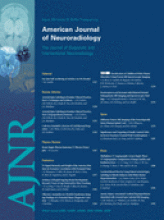I thank Galanaud et al for commenting on 2 of my articles published in the American Journal of Neuroradiology.1,2 In the cited study on the distribution of cortical signal-intensity changes,1 in addition to diffusion-weighted images (DWIs), we also used fluid-attenuated inversion recovery (FLAIR) images. All patients (N = 39) had cortical and 36 of 39 patients had deep gray matter changes in addition to cortical signal-intensity changes so that a stratification among molecular subtypes comparing patients with cortical and those with deep gray matter changes was not possible.1
Galanaud et al now report on a group of 20 patients with Creutzfeldt-Jakob disease (CJD) and 10 controls; of these, 15 patients with CJD and the controls were further studied by MR imaging (FLAIR and DWI). The genotypes on codon 129 of the patients with CJD were 8 MM, 6 MV, and 1 VV. In sporadic CJD, 6 different subtypes were found which share clinical and pathologic findings. These subtypes were shown to depend on: 1) the homozygosity and heterozygosity for methionine (M) or valine (V) at the polymorphic codon 129 of the prior protein gene and 2) the isoform of the pathologic prior protein (type 1 or 2). Thus, these subtypes are referred to as MM1, MM2, MV1, MV2, VV1, and VV2.
Galanaud et al report no difference in the extent and distribution of signal-intensity changes on FLAIR and DWI among the groups. Apparent diffusion coefficient (ADC) value calculation revealed significantly lower values in the deep gray nuclei in MV and VV patients compared with MM patients and controls. There was no difference in ADC values between MM patients and controls.
Galanaud et al address the following question: Is there a possibility of distinguishing the known molecular subtypes of sporadic CJD by MR imaging? Their answer is yes, by measurement of ADC values in the deep gray matter.
I have some problems with their study:
The isoform of the pathologic prion protein (PrPSc) was not given (because not all patients were autopsied). It is known that MM1 and MM2 patients differ substantially in their clinical and MR imaging presentation (MM2 have signal intensity abnormalities, mostly in the cortex; MM1, in the cortex and basal ganglia).3 MV1 patients clinically and in MR imaging are not distinguishable from those with the MM1 genotype. In many other studies, MM1 and MV1 patients are, therefore, considered as 1 group. In contrast to that, MV2 patients have less cortical and more striatal involvement.4 VV1 is extremely rare and has cortical (100%) and, less frequently (2/7 patients), striatal involvement,5 whereas VV2 is more frequent and patients have predominantly striatal changes.3 How can we be sure then that the patients presented by Galanaud et al were only MM1, MV2, and VV2? What would fit their results to current knowledge?
How do they explain that ADC values did not differ between MM patients and controls?
The extent of signal-intensity changes and the ADC values is known to depend on the disease stage.2 Did they correlate their data with the disease duration?
Groups were very small so that data should be interpreted with caution.
Were all patients from 1 institution? Techniques of DWI could otherwise differ between imaging centers.
In my opinion, analysis of ADC values is very helpful in the diagnosis of CJD, especially in the early stages of the disease when DWI might be the only sequence showing the pathologic changes.3 Currently, I do not see enough evidence that individual patient measurement of ADC values would help to distinguish between molecular subtypes.
References
- Copyright © American Society of Neuroradiology












